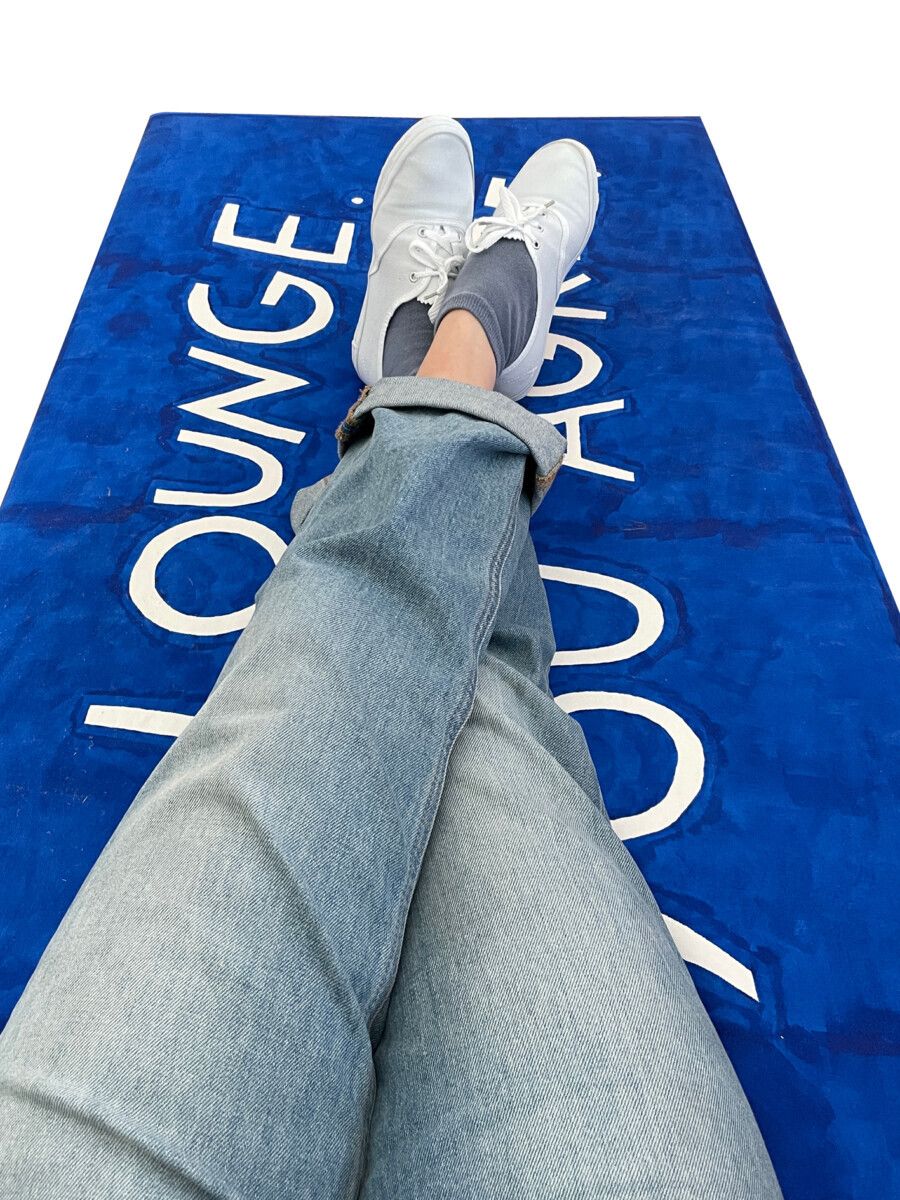-
Listen to the exhibition text read aloud.
read more
Slower is a show about pacing. Finnegan Shannon’s work often furnishes the conditions to spend time with others’ artwork. However pronounced their commentaries on infrastructure, Shannon’s benches and seating, in particular, make time. They collect acts of rest into a performative group utterance of assent: “Rest here if you agree.”The invitation may partake in a loose tradition of art historical contractualism, among any number of ways “participation” has been solicited. Beyond that, though, it’s also cross-disability culture extending itself to those who may not (yet, or ever) allow themselves to identify as disabled, but who might still acknowledge how good it feels to rest, as a feeling they might share with others.
The commonness of that feeling -- implied by the very provision of a seat, and named by the text painted on it -- marks access as a place to get together, whether or not you arrive at the same time. In this way, Shannon’s benches inside the gallery share an impulse with another series of projects, Anti-Stairs Club Lounge, which refuses to enter an inaccessible structure, instead outfitting a space to remain outside, waiting or boycotting in the present or implied company of others.
Audio description makes time, too. Not merely offering access to visual media, but rather making access with, the relay of description allows perception itself to appear, in all its sociability and variation, like a .jpg slowly rendering. Description requires what it extends: time to think, receive, transmit, absorb. In this case, what is relayed is not just visual: “access to the recent history of the gallery,” in Shannon’s words. Shannon asked Deborah to describe previous exhibitions, in part to get to know Deborah, the other artworks, and this place they’ve never been. It was also a way to get Deborah to slow down, and to “build a group show without having to bring objects back into the space.”
A solo show is an interesting problem, in this context. All of these works are fundamentally dependent on other people’s artworks that they appear to be in service of. The benches and audio description, in particular, rely for their function and rationale upon the presence of other works, to which they offer neither a frame, nor a commentary, but rather an altered temporality.
It’s tricky, then, to exhibit these works “by themselves,” instead of as support for and supported by a group. At a gallery, too, sitting feels different than it does at a museum or other aspirationally public institution. You often arrive and leave under the eye of the front desk, with the shifty feeling of entering a small store where things are for sale, but not to you. There’s a particular kind of standing engendered in this environment, a kind of rushed performance of contemplation, as if to politely nod at the exhibition. There’s no extended, anonymous wandering of institutional corridors, no neglected zones to spread out in, no cafeteria or coffee shop. In other words, there’s no pacing, no intervals. Is it the bench that gives the artwork time to unfold, or is the artwork also perhaps grounds to decelerate, sit down a bit longer? It’s difficult to rest in public without something to prop your mind on.
Here, however, the only visual objects to consider are the day clocks, which move so slowly that it’s hard to tell if they’re working at all. The manufacturer’s website, Shannon notes, markets day clocks as novelty gifts for retirees and beach homes, but also as access tools for those with memory loss. Shannon first saw a clock like this at a friend’s parents’ house and found themselves immediately drawn to it, with a kind of recognition, as a stray amulet of disability culture. They bought one and lived with it during the onset of the pandemic. Sometimes, to check if it was still running, they would have to leave the room and come back later. “What are the objects of disability culture?” Shannon asks. I think of Carolyn Lazard’s Extended Stay (2019), a small monitor showing live cable tv, mounted on a metal arm, of the kind found in hospital rooms. What are the textures and experiences of disability, shared across spaces and times that are often forcibly separated from one another?
The day clocks, in this way, recall Deborah’s descriptions of artwork that isn’t up right now, for people who were not able to be there in person. There’s a well-worn paradox by which disabled people, the world's “largest minority,” are nonetheless perhaps its most structurally isolated, separated, and exceptionalized; and this despite the fact that almost nothing feels better than being inside a large crowd of disabled people. Crip time happens at the tempo and variable syncopation of actual bodyminds in the process of assembling. But it is also the long delay, the doppler effect of missing each other, and getting together outside of time, even if it’s one at a time. My student Dani Halvorson is working on a project about letter-writing, with its descriptions of space-times in which we both are and are not together, as a crip practice; my friend Julie Tolentino talks about saving voicemail cassettes with messages from friends who have passed away. Slower is a show about pacing, which is to say it’s about intervals -- these may be intervals of perception, or rest, but they’re also the intervals by which we overlap even when we don’t appear to be there together.
Text: Amalle Dublon -
Hier können Sie den Ausstellungstext anhören.
read more
Slower ist eine Ausstellung, bei der es um die Einteilung von Zeit geht. Finnegan Shannons Werke stellen häufig die Bedingungen bereit, um Zeit mit Kunstwerken anderer zu verbringen. Doch wie ausgeprägt ihre Kommentare zur Infrastruktur auch sein mögen ‑ vor allem nehmen sich Shannons Bänke und Sitzgelegenheiten Zeit. Sie versammeln Ruhezustände zu einer performativen zustimmenden Gruppenäußerung: „Rest here if you agree.“ – „Ruh‘ hier aus, wenn du einverstanden bist.“Die Einladung mag Teil einer losen Tradition von kunsthistorischem Kontraktualismus sein, von allen möglichen Formen, mittels derer man um „Teilnahme“ ersucht wurde. Darüber hinaus handelt es sich aber auch um eine alle möglichen Formen von Behinderung einbeziehende Kultur, die sich auch auf all diejenigen erstreckt, welche es sich (noch) nicht (oder aber nie) erlauben, sich als behindert zu identifizieren, aber vielleicht dennoch anerkennen, wie gut es sich anfühlt, auszuruhen, als eine Empfindung, welche sie vielleicht mit anderen teilen.
Die Gewöhnlichkeit dieser Empfindung, die eben durch die Bereitstellung einer Sitzgelegenheit impliziert und durch den darauf gemalten Text benannt wird, kennzeichnet Zugang als einen Treffpunkt, ob man nun zur selben Zeit dort eintrifft oder nicht. Auf diese Weise verdanken sich Shannons Bänke in der Galerie demselben Antrieb wie eine andere Serie von Projekten, Anti-Stairs Club Lounge, die sich weigert, ein unzugängliches Gebäude zu betreten und stattdessen einen Raum so ausstattet, dass man draußen bleibt, in der gegenwärtigen oder implizierten Gesellschaft anderer wartet oder etwas boykottiert.
Auch die Audio-Beschreibung nimmt sich Zeit. Sie bietet nicht nur Zugang zu visuellen Medien, sondern verschafft sich Zugang mit ihnen; die Weitergabe der Beschreibung erlaubt es der Wahrnehmung, selbst in Erscheinung zu treten, mit all ihrer Soziabilität und Variation, wie eine langsame .jpg-Übertragung. Beschreibung verlangt das, was sie ausdehnt: Zeit zum Nachdenken, Empfangen, Übermitteln, Absorbieren. In diesem Fall ist das, was weitergegeben wird, nicht visuell: „Zugang zur jüngsten Geschichte der Galerie“ in Shannons Worten. Shannon bat Deborah, ihnen frühere Ausstellungen zu beschreiben, teils um Deborah, die anderen Kunstwerke und diesen Ort, wo sie nie gewesen sind, kennenzulernen. Es war auch eine Methode, Deborah dazu zu bringen, das Tempo zu drosseln und eine „Gruppenausstellung aufzubauen, ohne wieder Objekte in den Raum zurückzubringen“.
In diesem Kontext ist eine Einzelausstellung ein interessantes Problem. Alle diese Werke hängen im Grunde von den Kunstwerken anderer Menschen ab, in deren Diensten sie zu stehen scheinen. Was ihre Funktion und das ihnen zugrunde liegende Prinzip angeht, sind die Bänke und vor allem die Audio-Beschreibung auf die Präsenz anderer Werke angewiesen, denen sie weder einen Rahmen noch einen Kommentar, sondern vielmehr eine geänderte Zeitlichkeit bieten.
Es ist also heikel, diese Werke „für sich allein genommen“ auszustellen statt als Unterstützung für eine Gruppe oder unterstützt von dieser. Außerdem fühlt es sich anders an, in einer Galerie zu sitzen, als in einem Museum oder in einer anderen öffentlichen Institution. Man kommt und geht häufig unter den Blicken der Rezeption mit dem zwielichtigen Gefühl, einen kleinen Laden zu betreten, in dem die Dinge zum Verkauf stehen, aber nicht für einen selbst.
Diese Umgebung hat eine bestimmte Art des Stehens zur Folge, eine Art überstürzter Performanz des Betrachtens, als nicke man der Ausstellung höflich zu. Es gibt hier kein ausgedehntes, anonymes Durchwandern institutioneller Gänge, keine vernachlässigten Bereiche, um sich auszubreiten, weder eine Cafeteria noch ein Coffeeshop. Mit anderen Worten, es gibt keine Steuerung der Schritte, keine Intervalle. Die Bank gibt dem Kunstwerk Zeit, sich zu entfalten, oder ist das Kunstwerk vielleicht auch der Beweggrund, sich zu entschleunigen, etwas länger hinzusetzen? Es ist schwierig, sich in der Öffentlichkeit auszuruhen, ohne etwas zu haben, auf das man seine Gedanken lenken kann.
Aber hier sind die einzigen visuellen Objekte, die man betrachten kann, die Tagesuhren, die so langsam gehen, dass man kaum zu sagen vermag, ob sie überhaupt funktionieren. Die Website des Herstellers, so Shannon, vermarktet Tagesuhren als neuartige Geschenke für Rentner*innen und Strandhäuser, aber auch als Zugriffswerkzeuge für Menschen mit Gedächtnisverlust. Shannon sah eine solche Uhr erstmals im Elternhaus eines Freundes und fühlten sich selbst unmittelbar davon angezogen, als eine Art Anerkennung, als ein vereinzeltes Amulett der Behinderungskultur. Sie kauften eines und lebten während des Ausbruchs der Pandemie damit. Um herauszufinden, ob sie noch lief, mussten sie manchmal den Raum verlassen und später zurückkehren. „Was sind die Objekte der Behinderungskultur?“ fragt Shannon. Ich denke an Carolyn Lazards Extended Stay (2019), ein kleiner, auf einem Metallarm montierter Monitor, in dem Live-Kabelfernsehen läuft, wie man sie in Krankenhauszimmern findet. Was sind die Texturen und Erfahrungen der Behinderung, die über häufig gewaltsam voneinander getrennte Räume und Zeiten hinweg miteinander geteilt werden?
Auf diese Weise erinnern die Tagesuhren an Deborahs Beschreibungen eines Kunstwerks, das gerade nicht ausgestellt ist, für Menschen, die dort nicht persönlich anwesend sein konnten. Es gibt das abgedroschene Paradox, demzufolge behinderte Menschen, die „größte Minderheit“ der Welt, vielleicht nichtsdestoweniger ihre strukturell isolierteste, abgetrennteste und am stärksten zur Ausnahme erklärte sind: und dies ungeachtet der Tatsache, dass sich fast nichts besser anfühlt, als inmitten einer Menge behinderter Menschen zu sein. Crip Time ereignet sich im Tempo und in der variablen Synkopierung tatsächlicher Körper-und-Geister im Prozess des Zusammenkommens. Aber es ist auch die lange Verzögerung, der Dopplereffekt des Sich-Vermissens und des Außerhalb-der-Zeit-Zusammenfindens, selbst wenn eins nach dem anderen erfolgt. Mein Student Dani Halvorson arbeitet an einem Projekt über das Briefschreiben mit seinen Beschreibungen von Raum-Zeiten, in denen wir beide zusammen sind oder auch nicht, als eine Crip Praxis; meine Freundin Julie Tolentino spricht darüber, Voicemail-Kassetten mit Botschaften von Freund*innen aufzuheben, die verstorben sind. Slower ist eine Ausstellung, bei der es um die Steuerung von Schritten geht, d.h. es geht dabei um Intervalle: Das mögen Intervalle der Wahrnehmung oder der Ruhe sein, aber es sind auch Intervalle, durch die wir uns überschneiden, selbst wenn wir dort nicht zusammen zu sein scheinen.
Text: Amalle Dublon (übersetzt aus dem Englischen)
Wednesday – Friday 12 – 6 pm
Saturday 12 – 4 pm and by appointment
Finnegan Shannon
Slower
07.05. – 17.06.2022
-
Listen to the exhibition text read aloud.
read more
Slower is a show about pacing. Finnegan Shannon’s work often furnishes the conditions to spend time with others’ artwork. However pronounced their commentaries on infrastructure, Shannon’s benches and seating, in particular, make time. They collect acts of rest into a performative group utterance of assent: “Rest here if you agree.” -
Hier können Sie den Ausstellungstext anhören.
read more
Slower ist eine Ausstellung, bei der es um die Einteilung von Zeit geht. Finnegan Shannons Werke stellen häufig die Bedingungen bereit, um Zeit mit Kunstwerken anderer zu verbringen. Doch wie ausgeprägt ihre Kommentare zur Infrastruktur auch sein mögen ‑ vor allem nehmen sich Shannons Bänke und Sitzgelegenheiten Zeit. Sie versammeln Ruhezustände zu einer performativen zustimmenden Gruppenäußerung: „Rest here if you agree.“ – „Ruh‘ hier aus, wenn du einverstanden bist.“
-
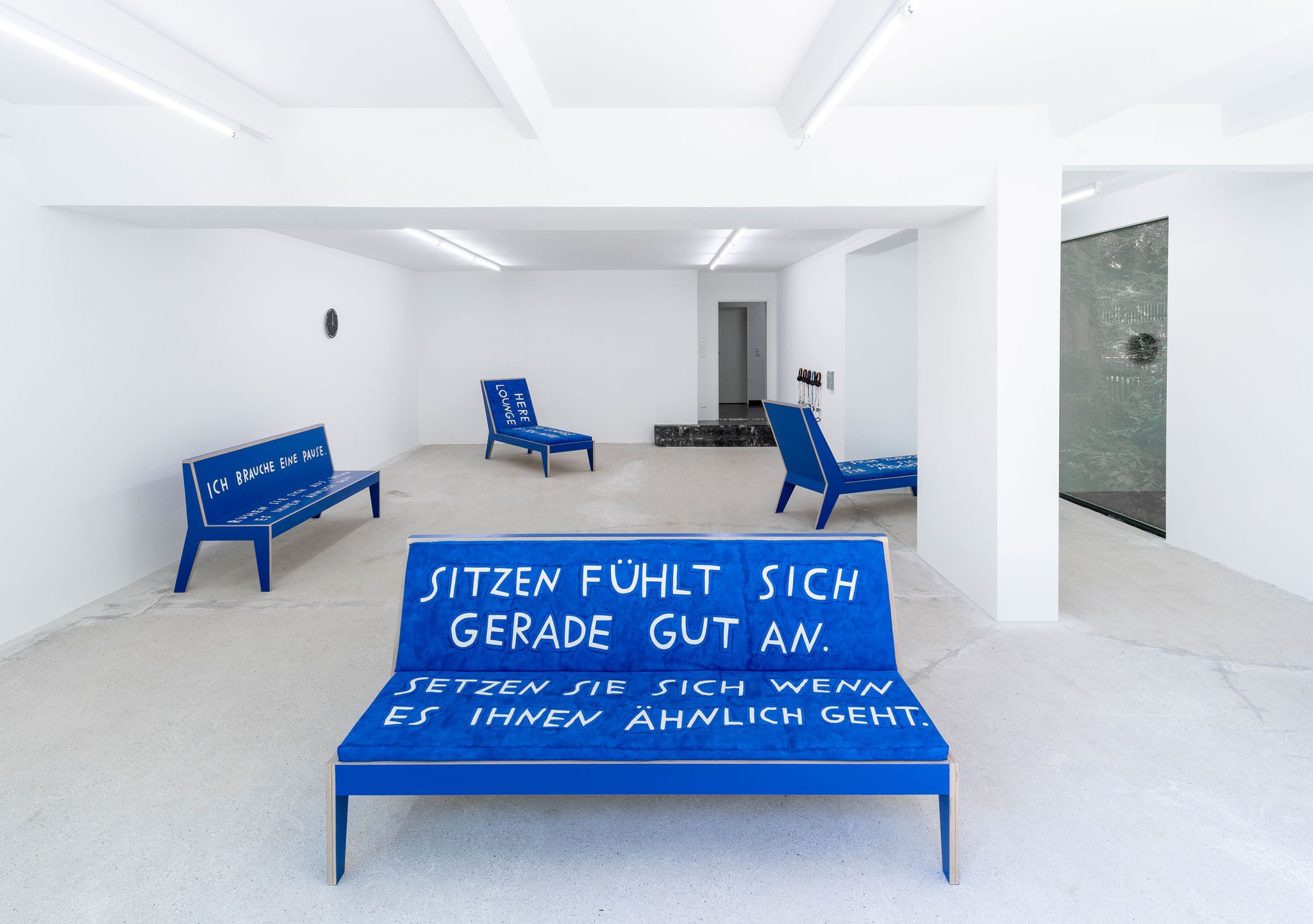
Finnegan Shannon, Slower, Installation view, Deborah Schamoni, 2022, Image description: Two blue benches and two chaise lounges in an exhibition room, all have text written in white letters on them. They are all facing different directions, scattered around the room. In the background, there’s a black clock and on the opposite side of the room, there are five headphones hanging on a wall. -
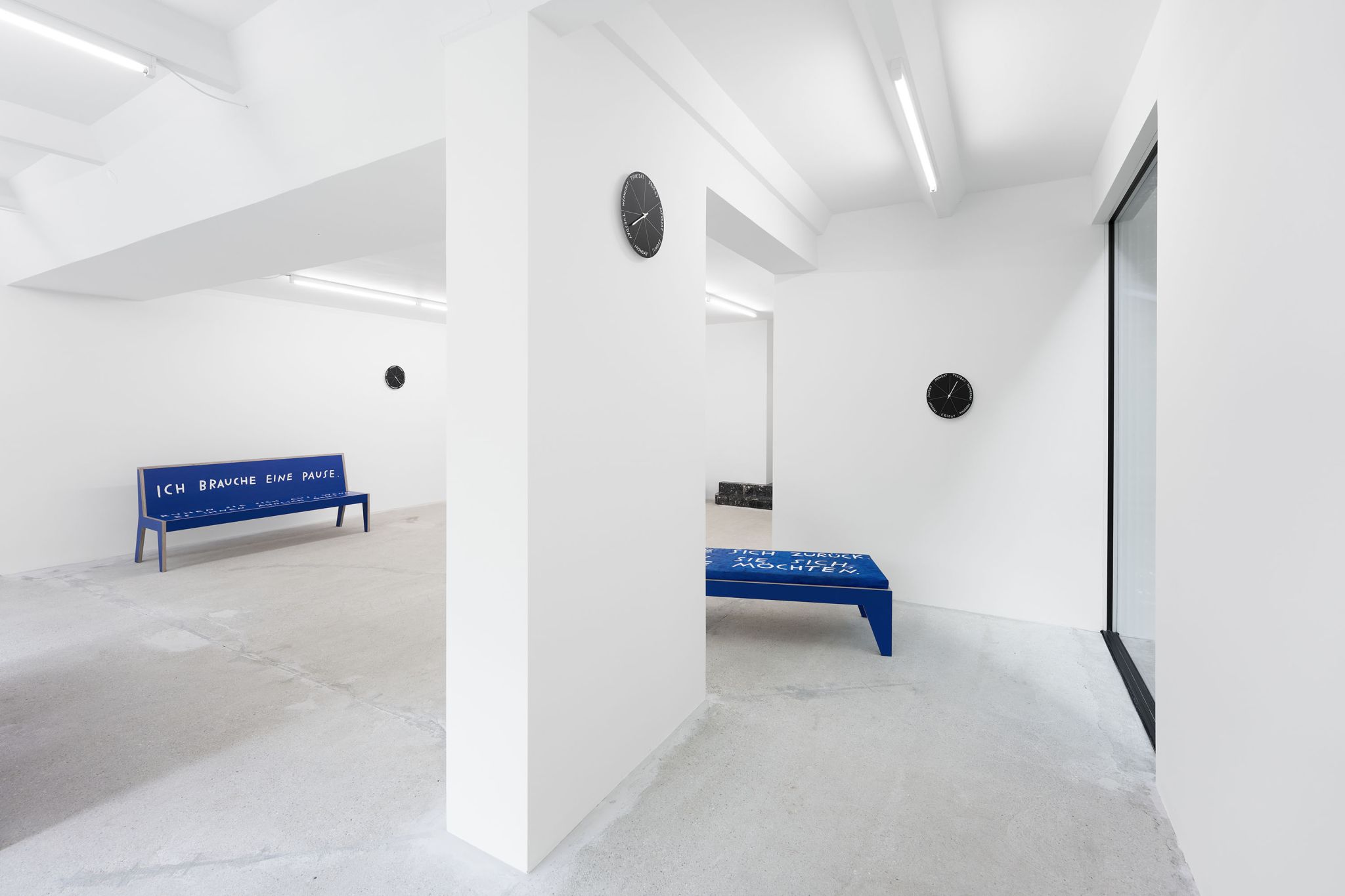
Finnegan Shannon, Slower, Installation view, Deborah Schamoni, 2022, Image description: Inside an exhibition room there is one blue bench with white letters on it. Part of another piece of blue furniture is in view, cut off by column in the space. Three black clocks are hanging on different walls at different heights. -
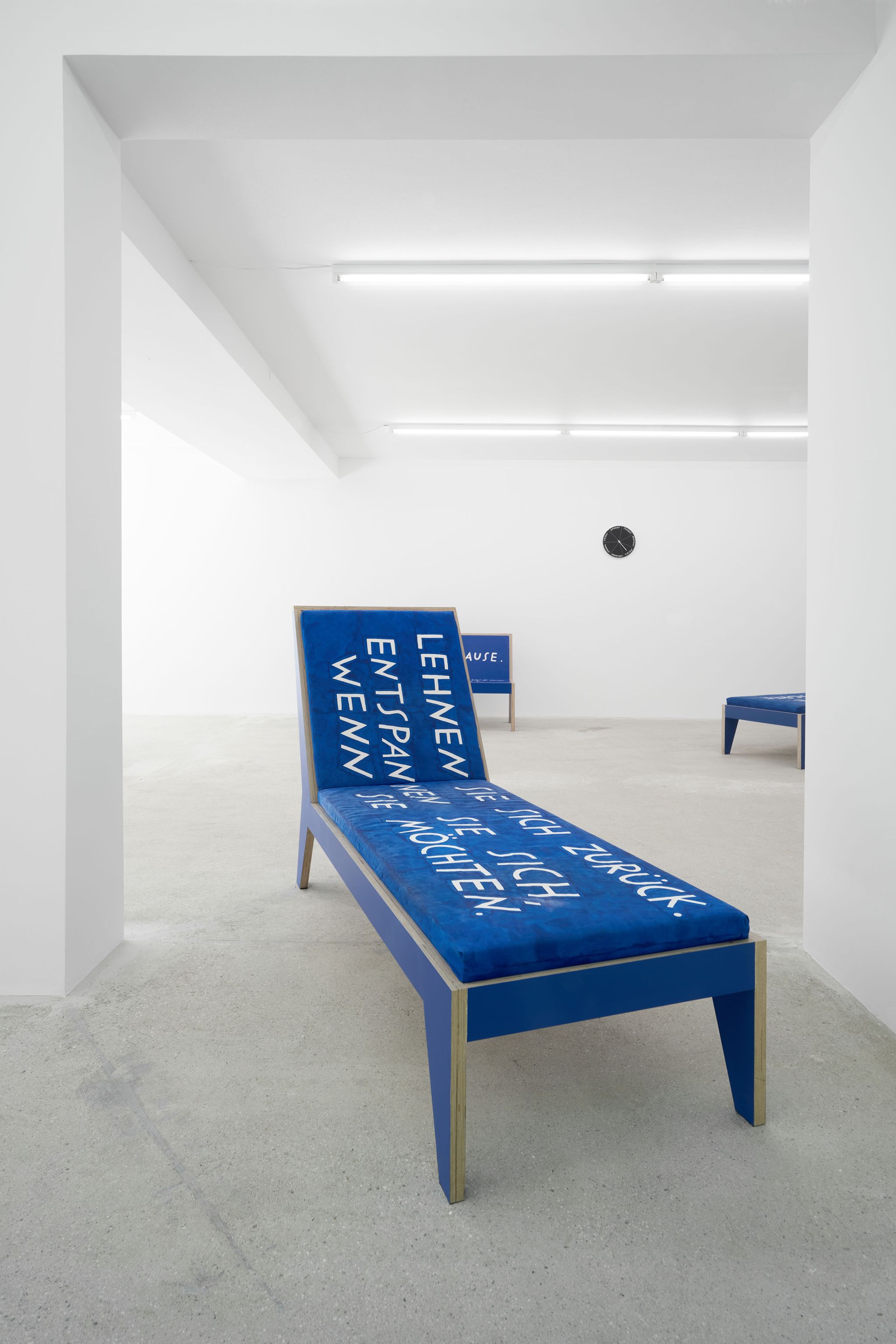
Finnegan Shannon, Do you want us here or not (MMK) – Chaise lounge 1, 2021
Plywood, paint, foam, fabric, fabric paint, 110.5 × 190 × 68.5 cm, Image description: Two blue chaise lounges and a blue bench are in an exhibition room. All have different hand-painted text on them. A black clock is hanging on the wall in the background. -
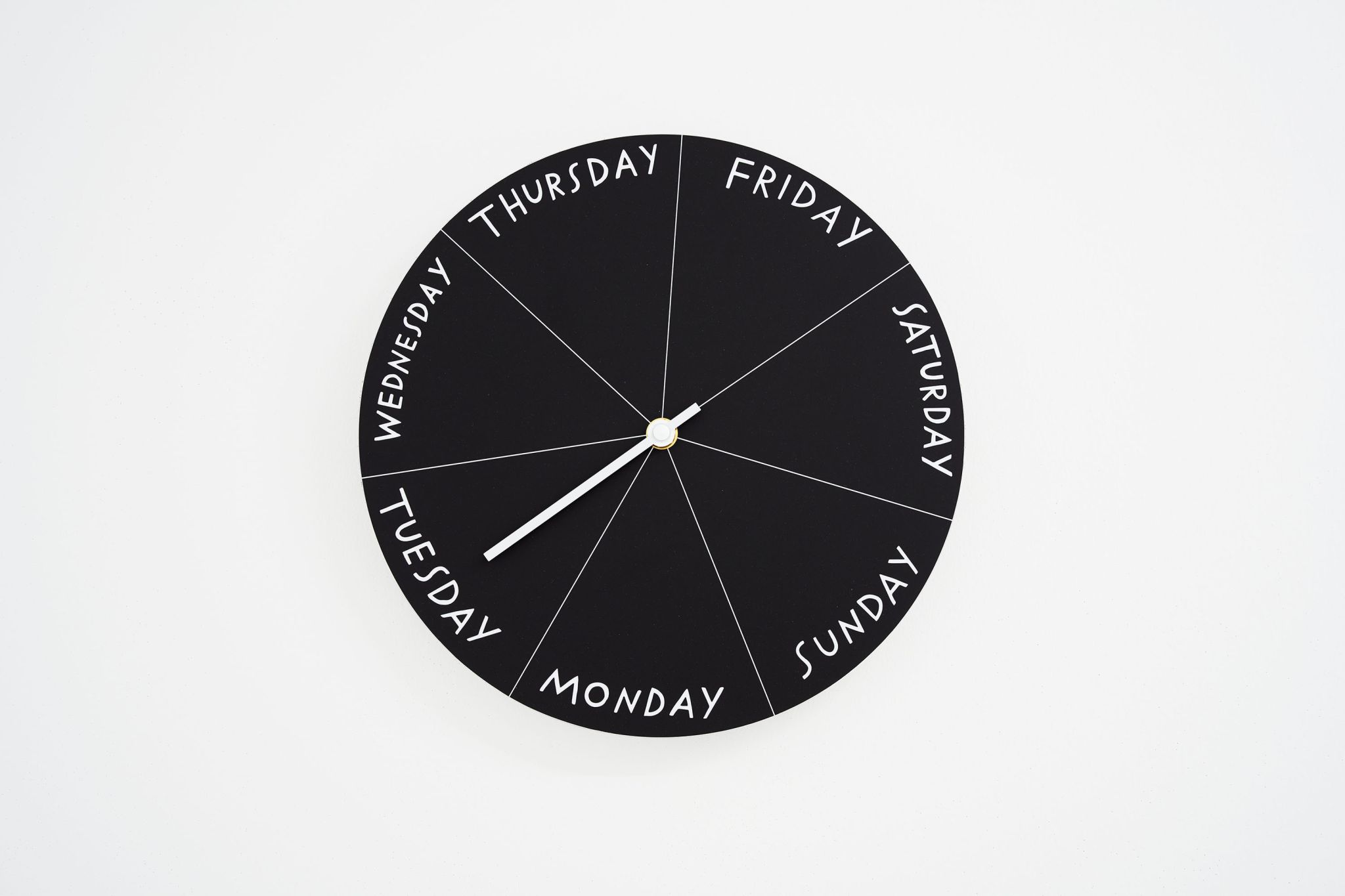
Finnegan Shannon, ave you ever fallen in love with a clock? - Friday, 2021
Day Clock mechanism, DiBond, clock hand, paint, ø 34 cm, Image description: A black and white clock hanging on a wall. Around the edge are the days of the week in handwritten capital letters. The clock hand points to Tuesday. On the 1 o’clock position, it says “Friday.” The other days of the week follow around the clock. -
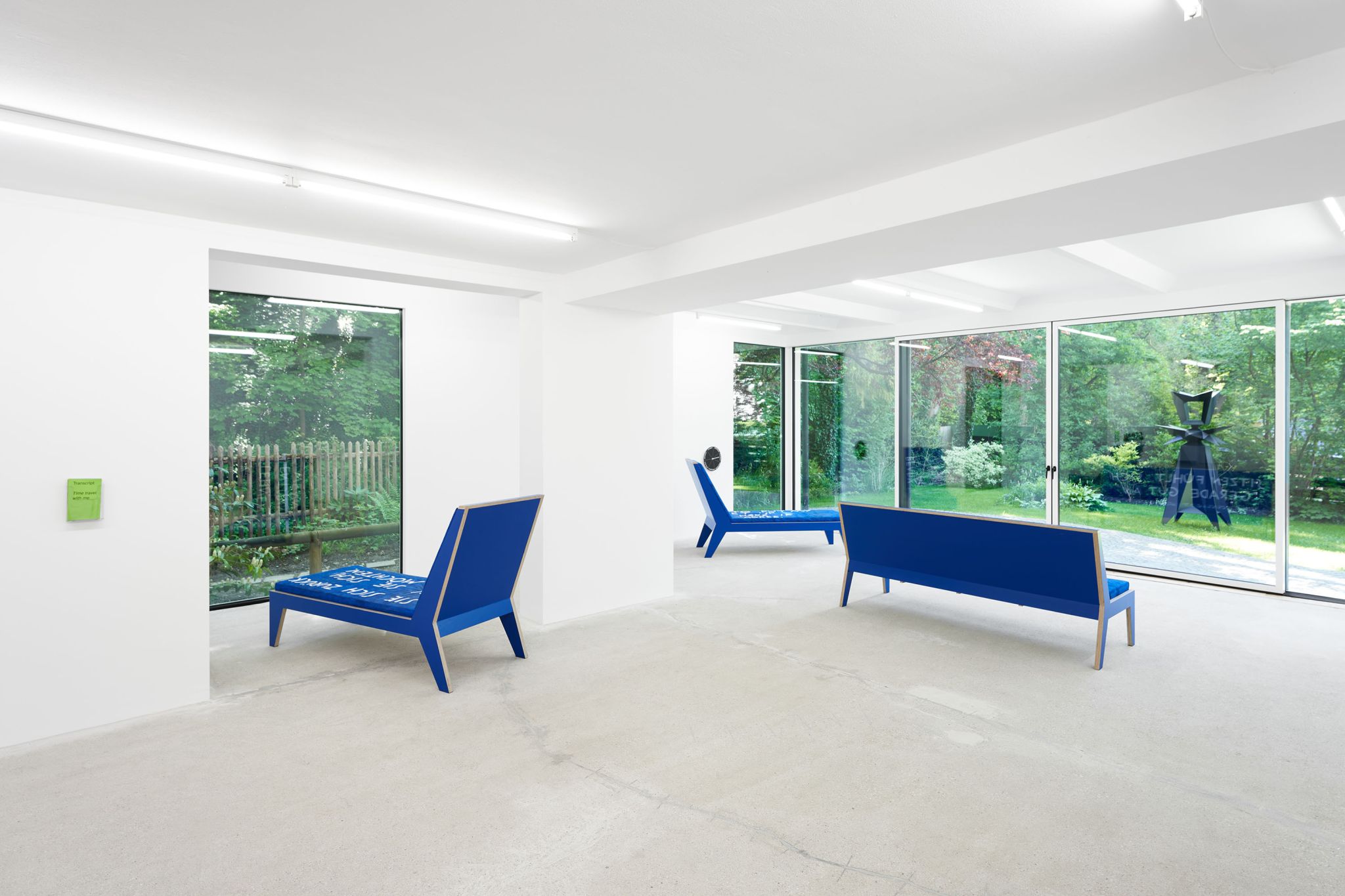
Finnegan Shannon, Slower, Installation view, Deborah Schamoni, 2022, Image description: Two blue chaise lounges and a blue bench in an exhibition room. They all face towards different windows into a garden. A green zine and a black clock are hanging on different walls. -
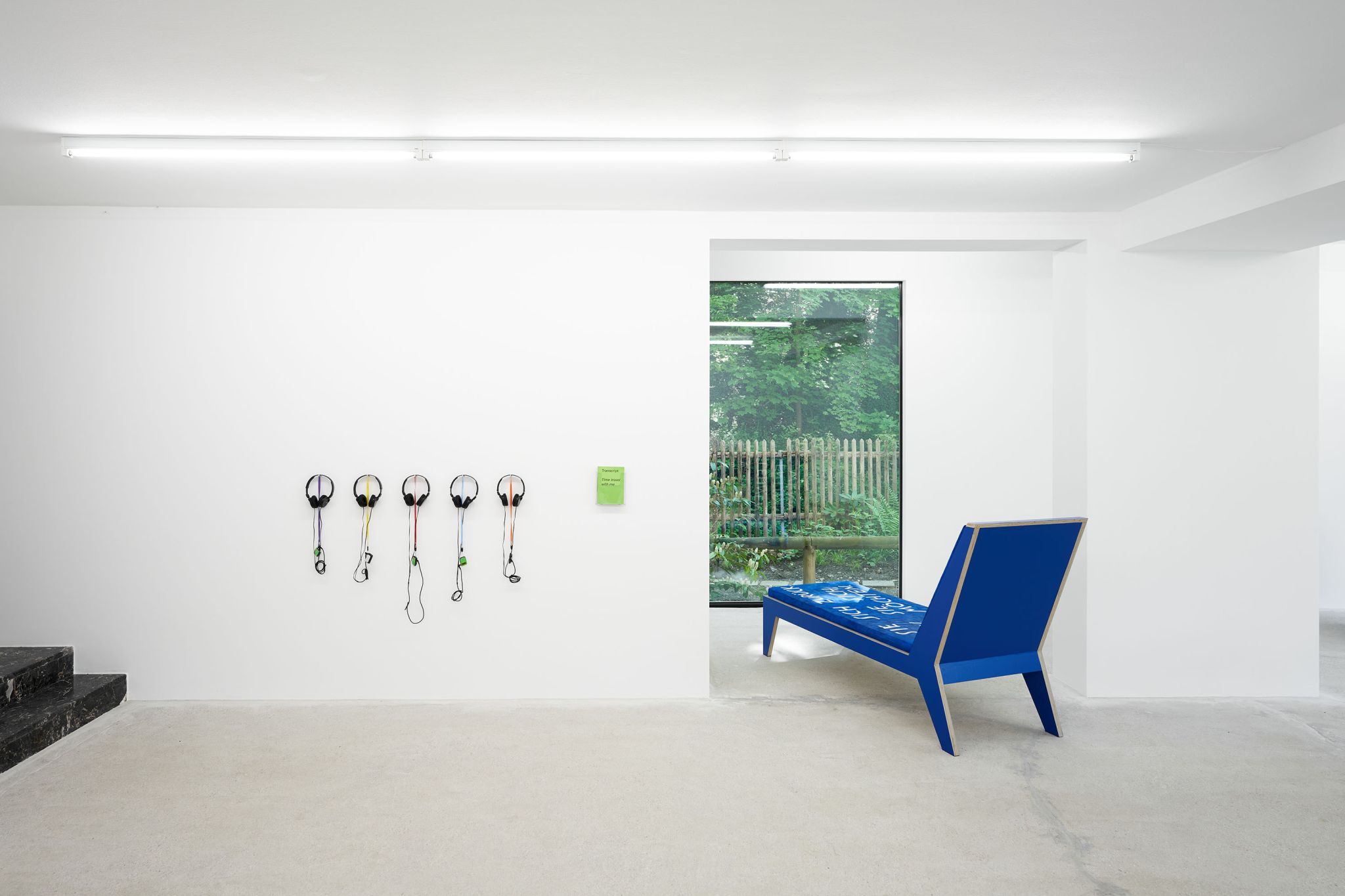
Finnegan Shannon, Slower, Installation view, Deborah Schamoni, 2022, Image description: Five headphones plugged into mp3 players are hanging on a wall next to a blue chaise lounge facing out of the window. -
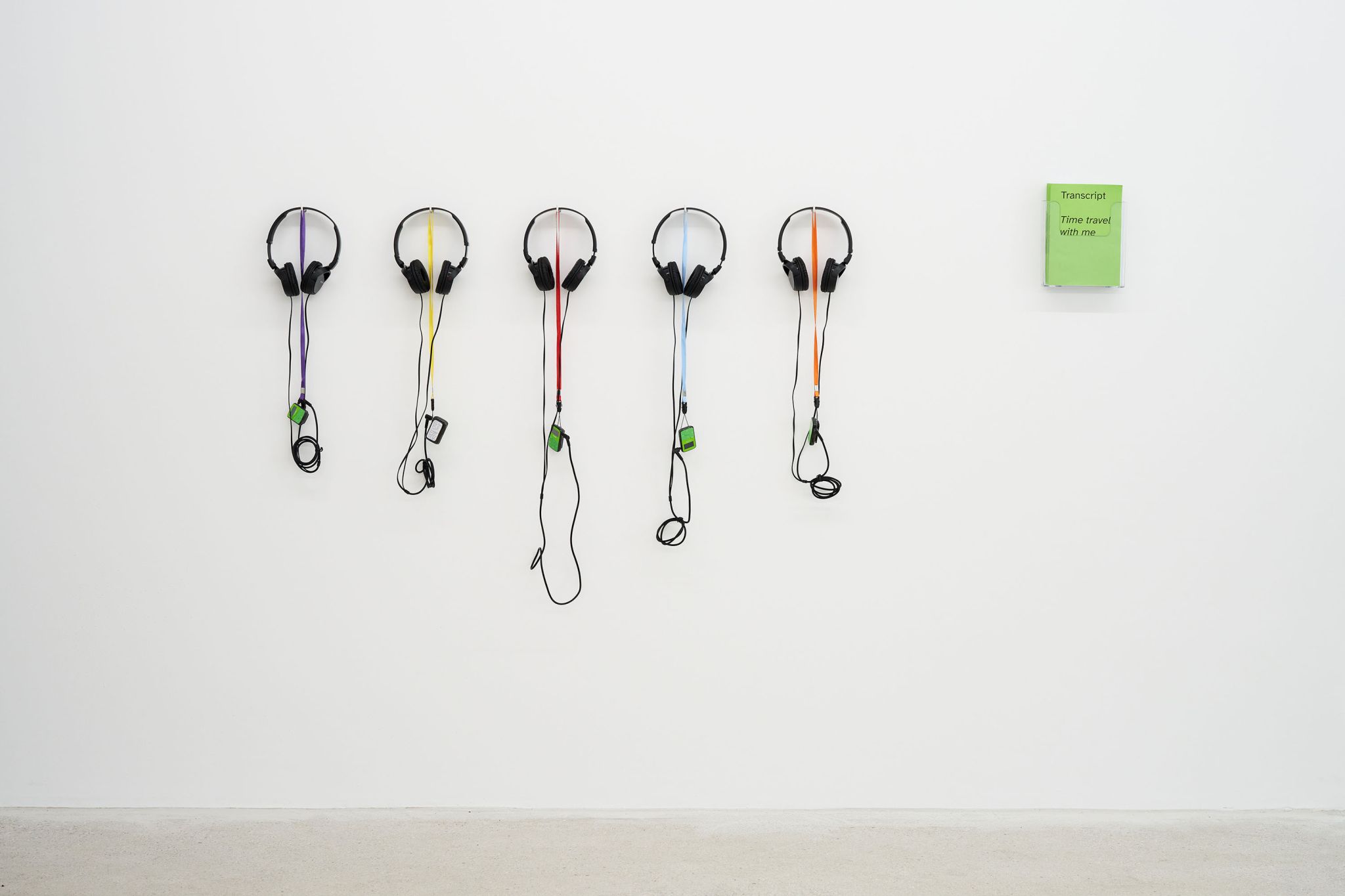
Finnegan Shannon, Time travel with me, 2022
Audio, mp3-Player, lanyard, headphones, transcript, zine, Image description: Five headphones plugged into mp3 players are hanging on a wall. Next to them a zine with a bright green cover. On it, it says “Transcript” and “Time travel with me.” -
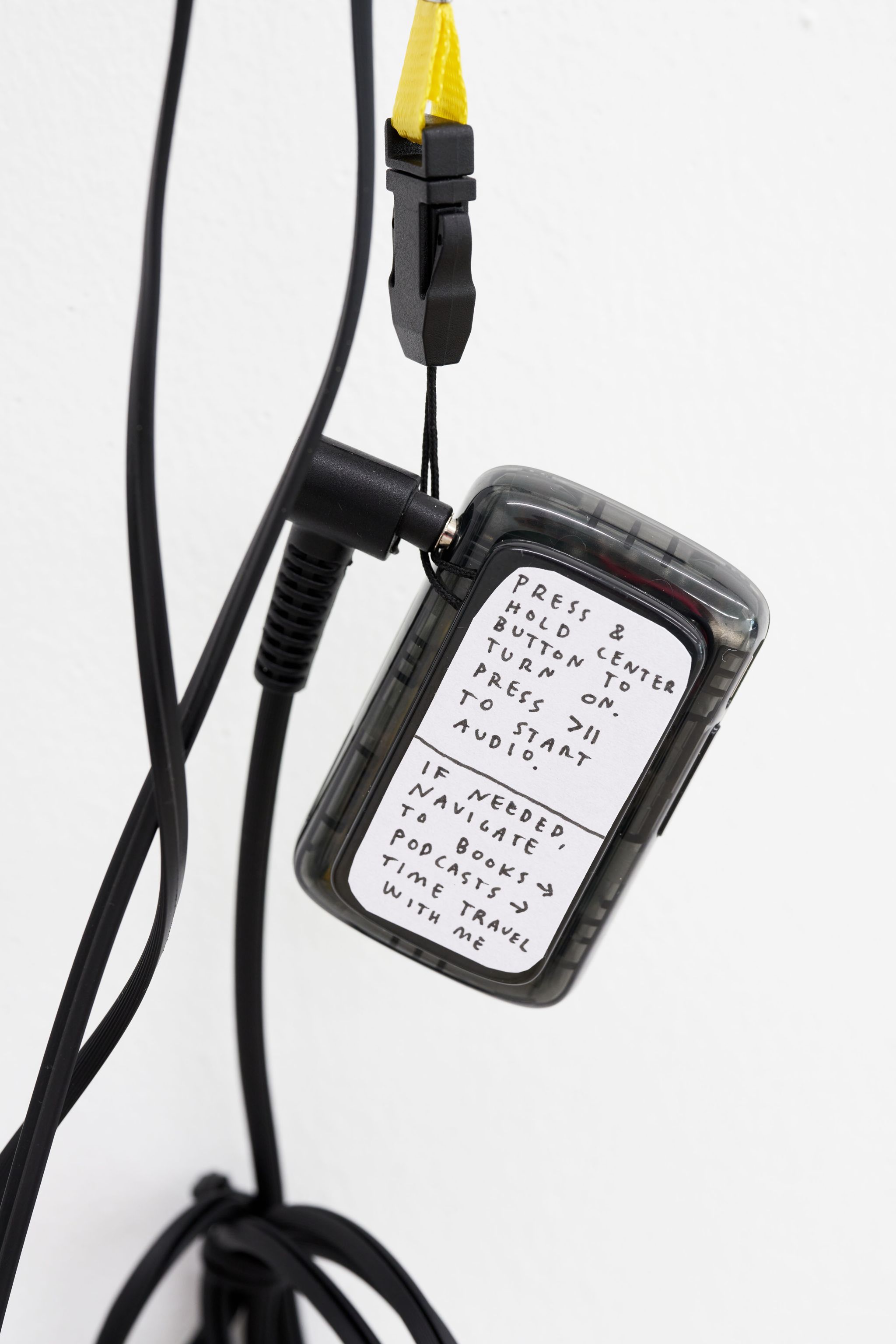
Finnegan Shannon, Time travel with me (detail), 2022
Audio, mp3-Player, lanyard, headphones, transcript, zine, Image description: The back of a mp3 player. On it there’s a sticker with a handwritten instructions for how to play the audio. -
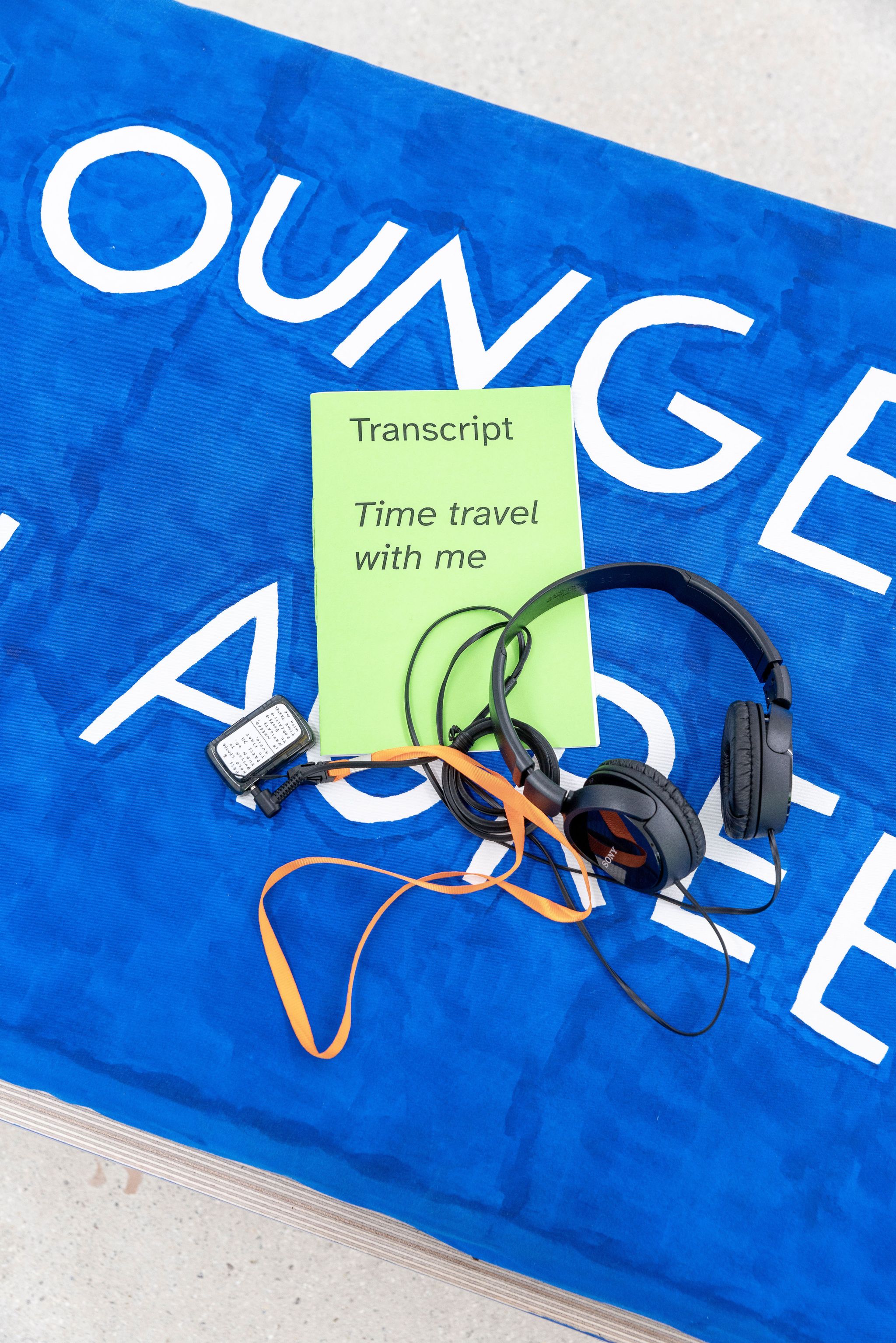
Finnegan Shannon, Time travel with me, 2022
Audio, mp3-Player, lanyard, headphones, transcript, zine, Image description: Headphones plugged into an mp3-Player and a zine laying on a blue piece of furniture. On the zine, it says “Transcript” and “Time travel with me.” The player is flipped, the back shows a sticker with handwritten instructions for how to play the audio. -
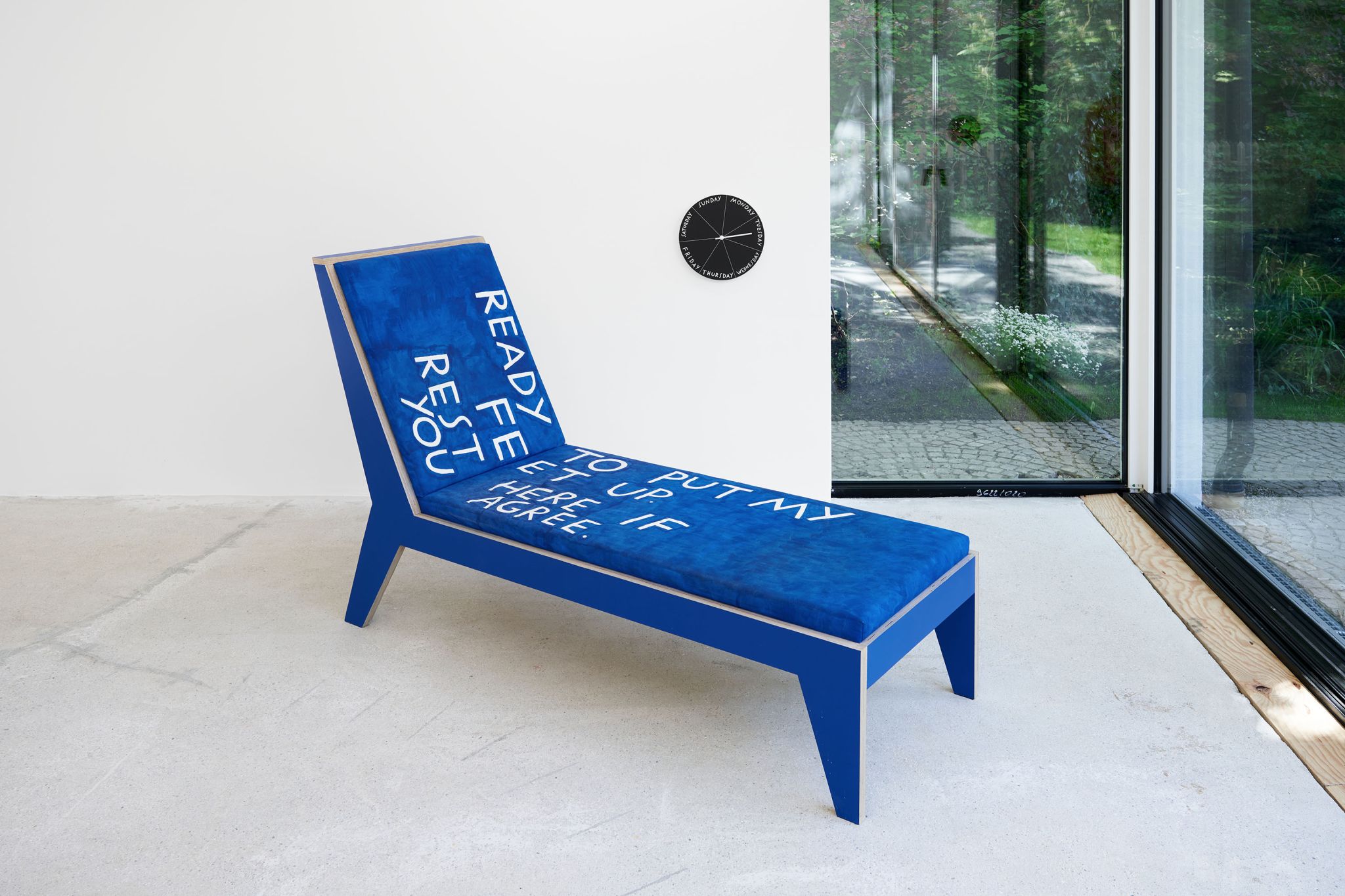
Finnegan Shannon, Do you want us here or not (MMK) – Chaise lounge 2, 2021
Plywood, paint, foam, fabric, fabric paint, 110.5 × 190 × 68.5 cm, Image description: A blue chaise lounge with white letters on it in an exhibition room. The letters read “Ready to put my feet up. Rest here if you agree.” The chaise lounge is facing out of the big window with views of a lush garden. A black Day Clock is hanging next to it. -
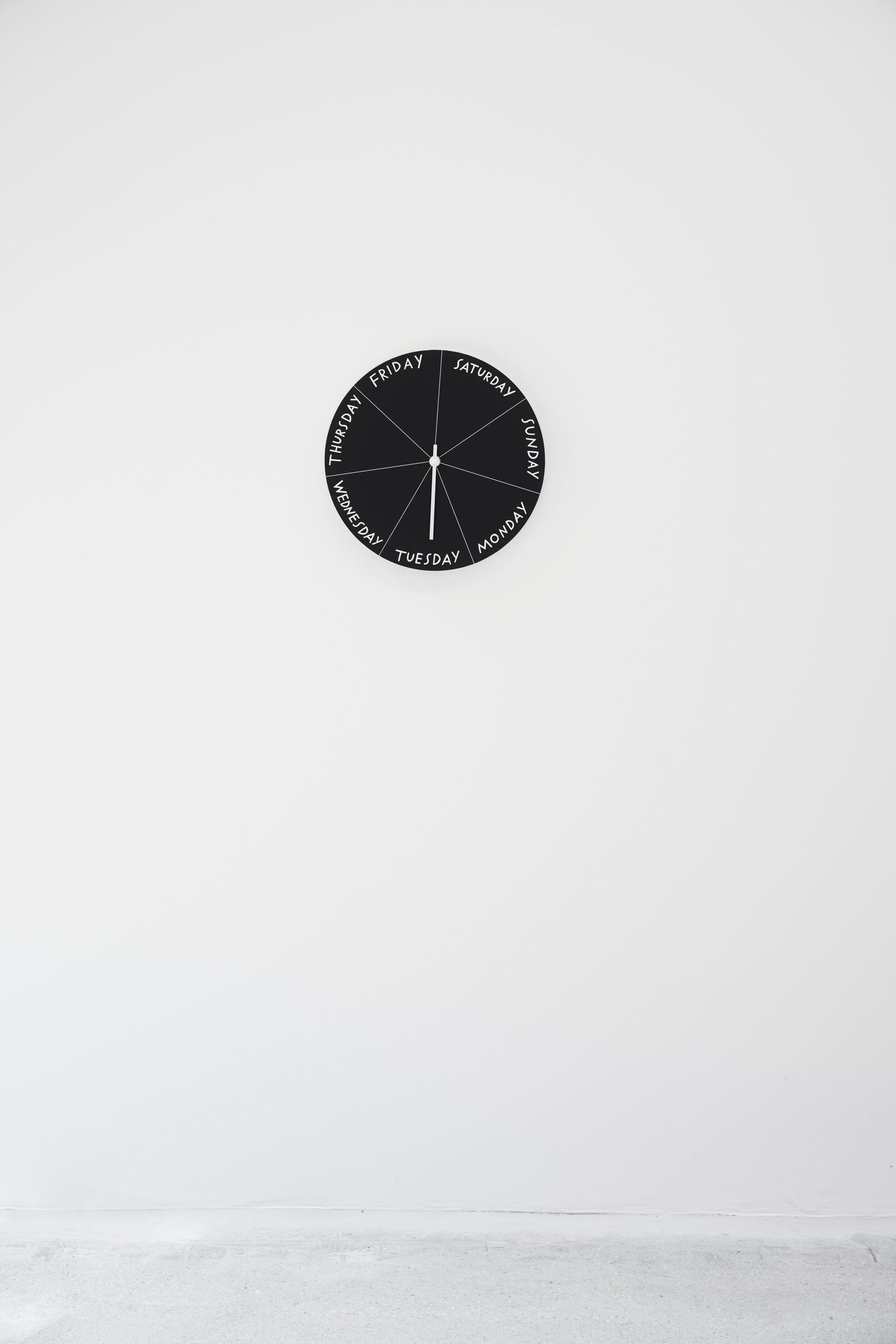
Finnegan Shannon, Have you ever fallen in love with a clock? – Saturday, 2021
Day Clock mechanism, DiBond, clock hand, paint, ø 34 cm, Image description: A black Day Clock is hanging on a wall, the white clock hand is pointing to Tuesday. On the 1 o’clock position, it says “Saturday”. The other days of the week follow around the clock. -
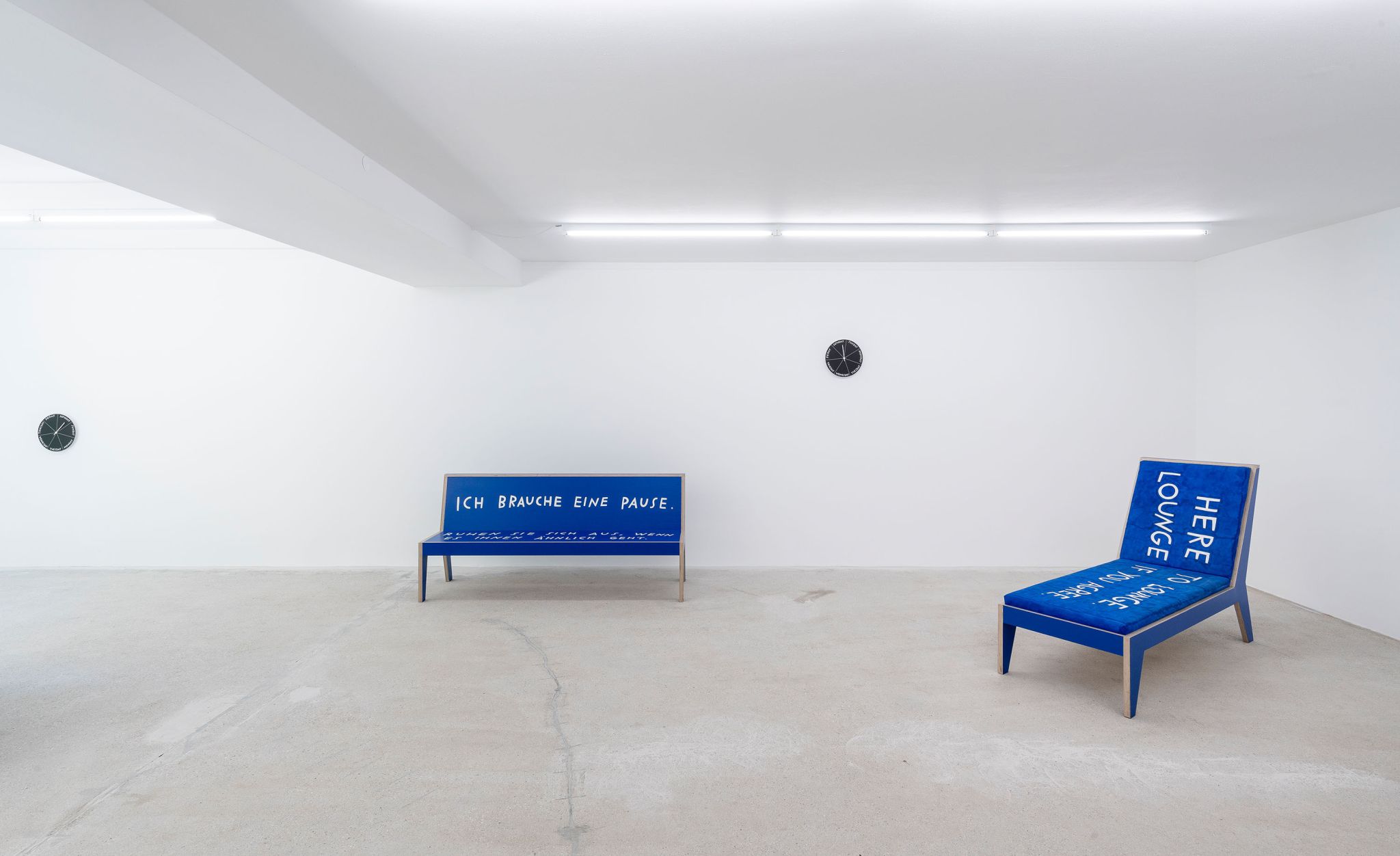
Finnegan Shannon, Slower, Installation view, Deborah Schamoni, 2022, Image desription: A blue bench and a blue chaise lounge in an exhibition room. Both have text in white letters on them, one in German, the other in English language. Both texts invite the viewer to rest. Two black clocks are hanging on the wall in different heights. -
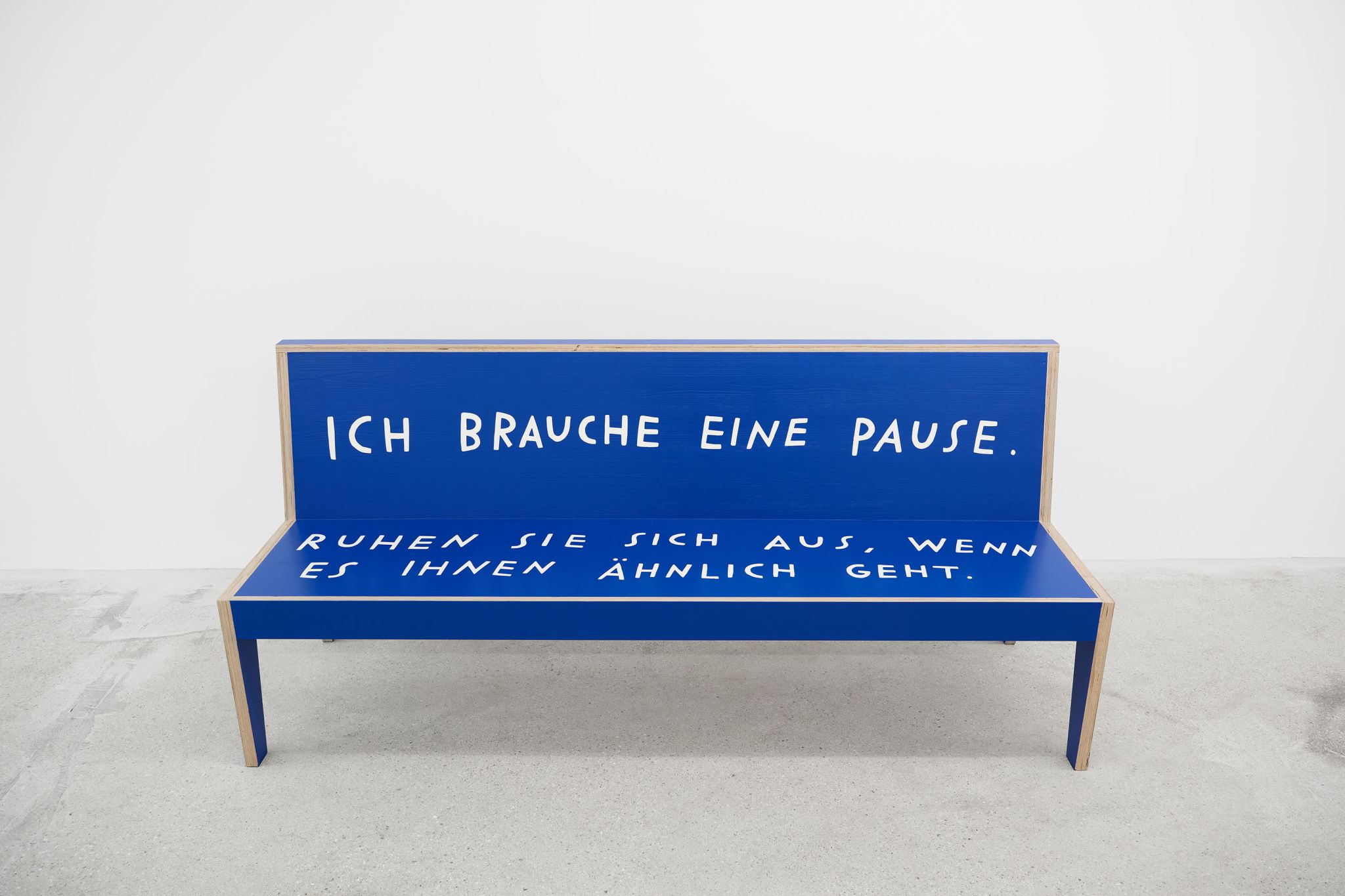
Finnegan Shannon, o you want us here or not (MMK) – Bench 6, 2021
Plywood, paint, 90 × 200 × 55 cm, Image description: A blue bench is standing in an exhibition room. It has white letters on it, that read “I need a break. Rest here if you agree” in German language. -
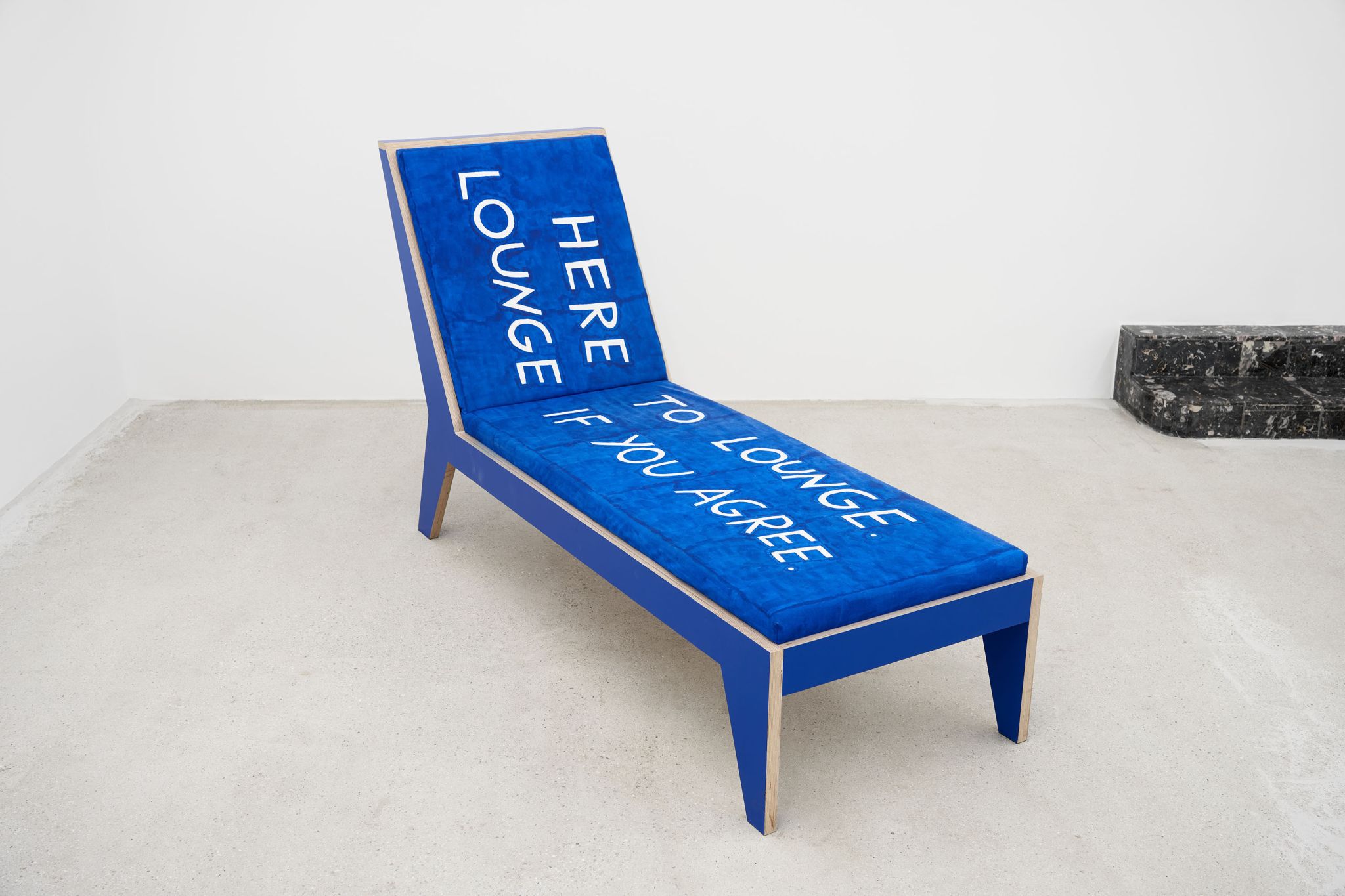
Finnegan Shannon, Do you want us here or not (MMK) – Chaise lounge 3, 2021
Plywood, paint, foam, fabric, fabric paint, 110.5 × 190 × 68.5 cm, Image description: A blue chaise lounge is standing in an exhibition room. On it, white letters read “Here to lounge. Lounge if you agree”. -
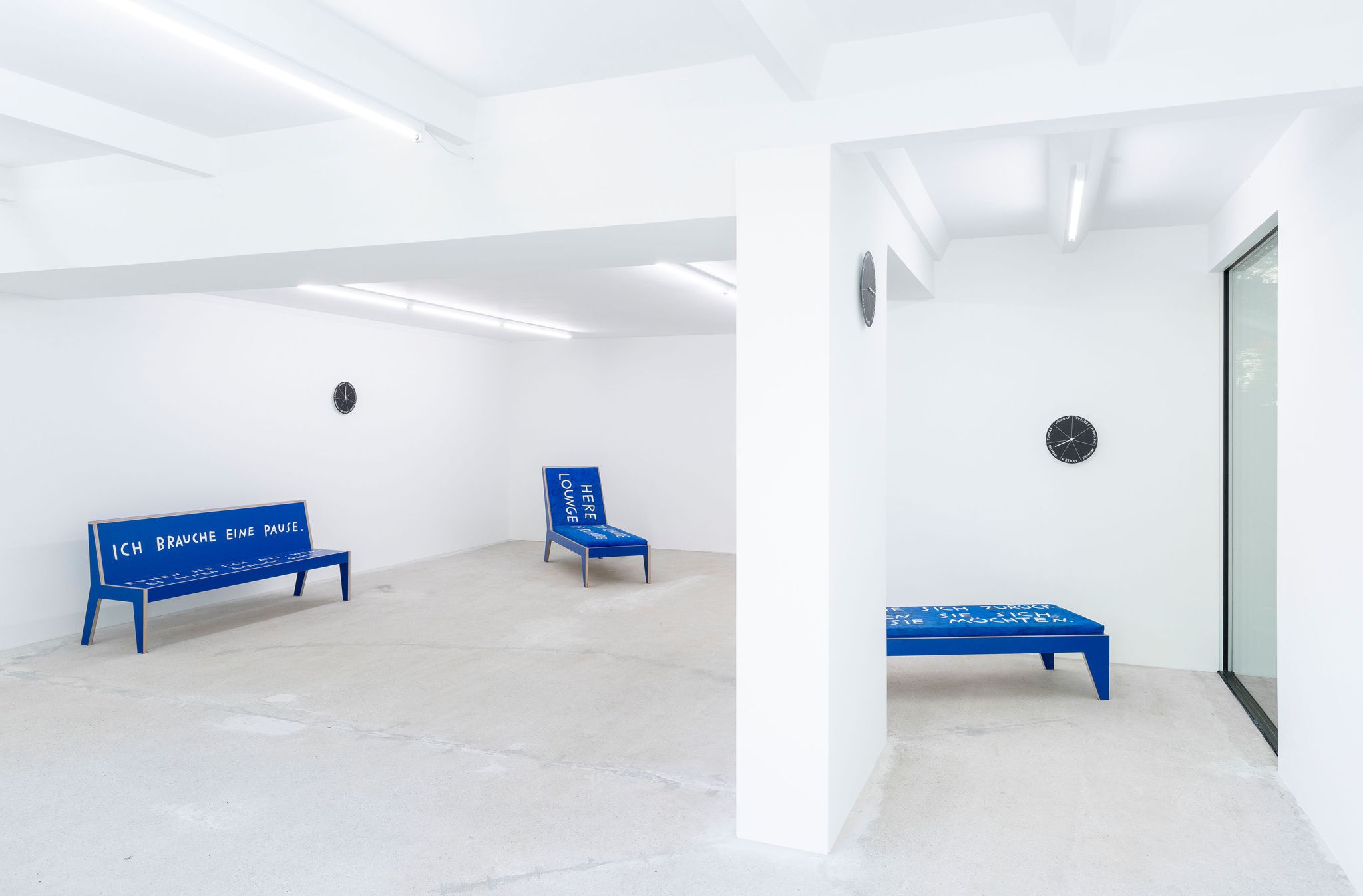
Finnegan Shannon, Slower, Installation view, Deborah Schamoni, 2022, Image description: Two blue benches and two chaise lounges in an exhibition room, all have text written in white letters on them. They are all facing different directions, scattered around the room. In the background, there’s a black clock and on the opposite side of the room, there are five headphones hanging on a wall. -
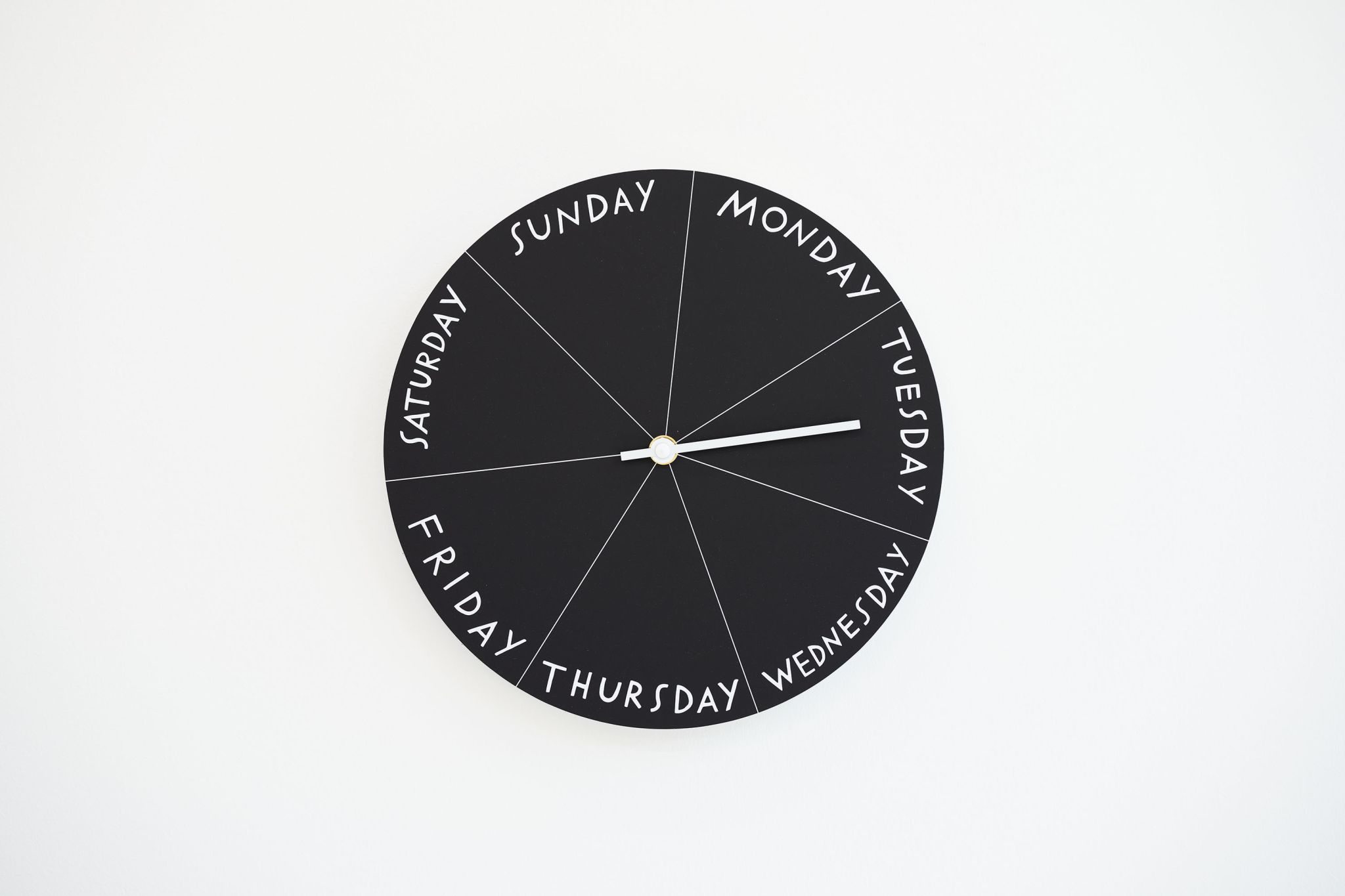
Finnegan Shannon, Have you ever fallen in love with a clock? - Monday, 2021
Day Clock mechanism, DiBond, clock hand, paint, ø 34 cm, Image description: A black Day Clock is hanging on a wall. The white clock hand is pointing to Tuesday. On the 1 o’clock position, it says “Monday”. The other days of the week follow around the clock. -
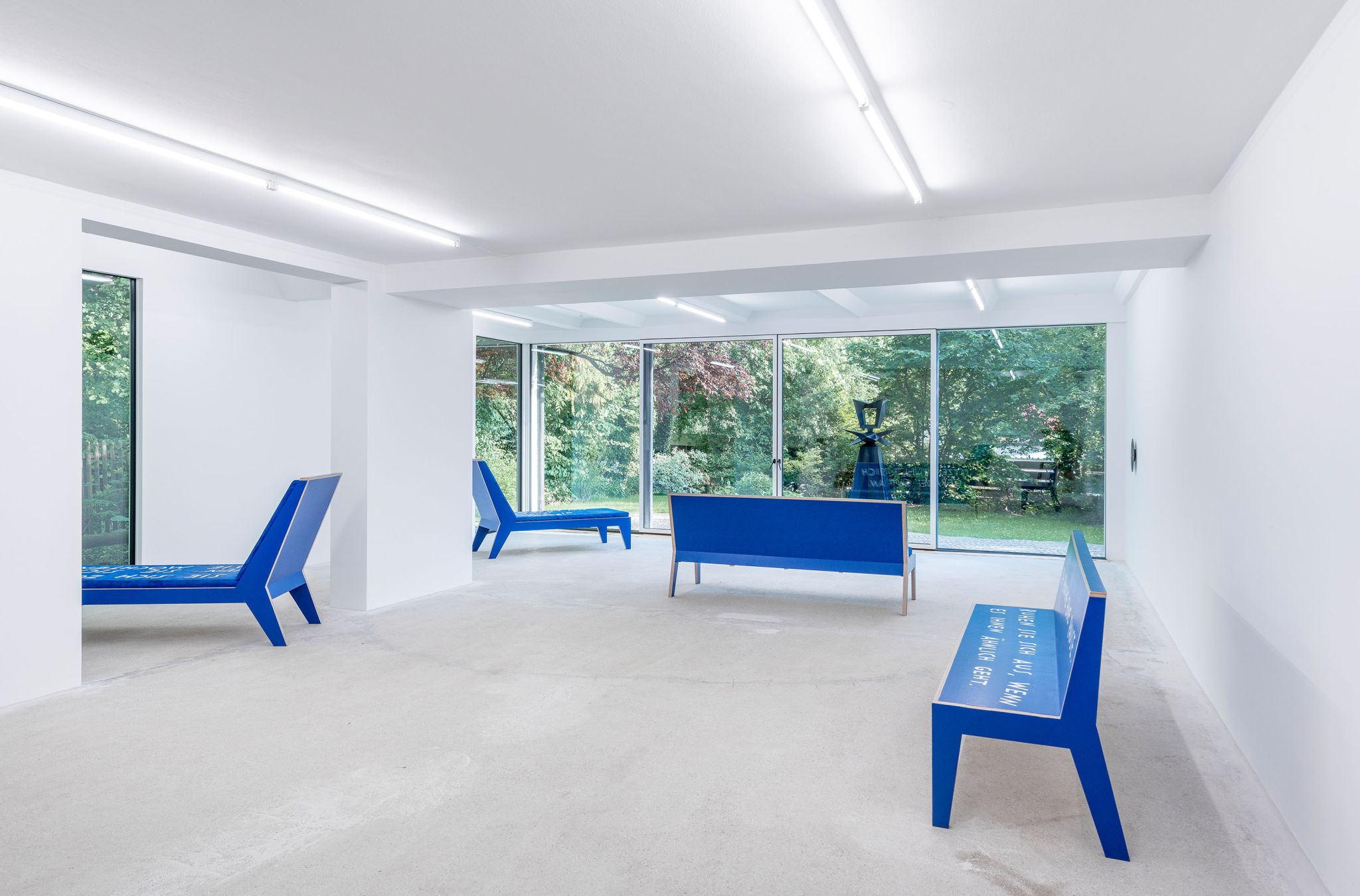
Finnegan Shannon, Slower, Installation view, Deborah Schamoni, 2022, Image description: Two blue chaise lounges and two blue benches in an exhibition room. They all face towards different windows into a garden. -
